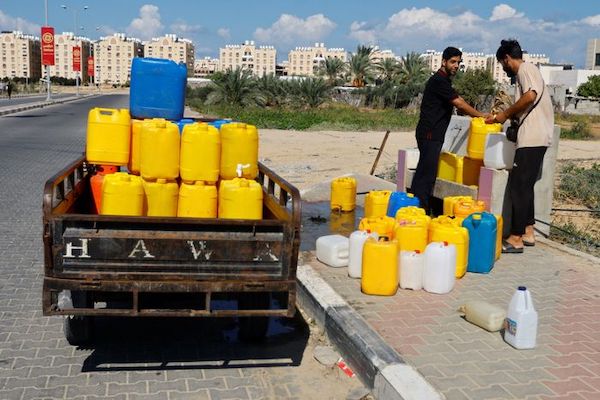On Wednesday, President Biden announced Israel would not block some humanitarian aid from entering the Gaza Strip via Egypt, partially reversing a two-week-old ban put into place after the Hamas attack on October 7. Human-rights experts said the food, medicine, and water will do little to mitigate the looming humanitarian disaster. The most acute form of deprivation is safe drinking water, which threatens the lives of over 2 million people.
That’s because the infrastructure to distribute water was in a critical state even before the current crisis. The decades-long conflict between Israel and Hamas has denied the Gaza Strip of the resources to invest in a robust water system. “The baseline was already quite limited,” says Omar Shakir, Israel and Palestine director at Human Rights Watch. “So that even a step that might have been significant in the pre-October 7 context is going to be even more limited in terms of how much it helps the population.”
With no natural lakes or permanent rivers, Gaza had been getting the water through three principal sources. About 90 percent is groundwater from the Coastal Aquifer Basin, which is fed by rainfall across Gaza and southern Israel. Gaza’s highly dense population has been drawing from the aquifer about twice as fast as it’s being replenished. “When you overpump a coastal groundwater system, often salt water penetrates. So it’s salty,” says Peter Gleick, an environmental scientist at the Pacific Institute in Oakland, California, who has studied Gaza’s water infrastructure. The water is also polluted with nitrates that have leached in from agricultural fertilizer and both human and animal waste. About 96 percent of the aquifer’s water is considered undrinkable. Even to get the water requires pumps that run on electricity or diesel fuel, supplies of both of which have now been cut.
About 6 percent comes via three pipelines from Israel’s state-owned water company, Mekorot. On Monday, a pipeline feeding the southern Gaza city of Khan Younis began to flow again, but according to the United Nations, it only delivered about 4 percent of the territory’s normal consumption.
The third and smallest source of water is from desalination plants, which extract fresh water from seawater. This had been a bright spot for Gaza as new capacity came online in recent years, including a UNICEF-funded plantthat opened in 2017 and was able to produce 1.5 million gallons a day. But without electricity or fuel to generate electricity locally, the desalination plants have fallen idle. The U.N. reports that the last major desalination plant powered down on Sunday. To the extent that any capacity remains at all, it would be coming from a scattering of privately owned desalination systems. “They have some small desalination plants that run on solar that might be able to desalinate a little bit of water over time,” says Gleick.
The World Health Organization sets 50 liters per day as the minimum to ensure that most basic human needs are met, such as drinking and washing. Before the blockade, Gazans were using 82.7 liters per day, compared to 240 to 300 liters per day by Israelis. The U.N. now estimates that Gazans are getting three. “People are very much conserving their use of water,” says Shakir. “They’re making difficult choices when it comes to how much to drink and how to use water.”
Shutting Gaza off from fresh water doesn’t mean that there is suddenly none at all available. Throughout Gaza, many residents are normally supplied by water tanker trucks and store the water in cisterns on the roof. The difficult decision that they now have to make is how much to use and for what purposes. As stored water dwindles, some will inevitably find themselves in a more dire situation than others.
The major health concern is dehydration. The human body needs about a gallon of water a day to function. People who get less than that begin to suffer from thirst, headaches, fatigue, dizziness, dry mouth, and dark urine. Toxins build up in the body and can eventually damage the kidneys. Without any water at all, humans can only expect to live about a week — less with heat and exertion.
“We need to truck fuel into Gaza now. Fuel is the only way for people to have safe drinking water. If not, people will start dying of severe dehydration,” said Philippe Lazzarini, UNRWA commissioner-general, in a press statement on October 14.
For his part, Gleick doesn’t see the major danger being dehydration — “People aren’t dying of thirst,” he says — but rather disease. “People can get sick from contaminated water, either in the short run with water-related diseases or in the long run from the chemicals and the contaminants,” he says.
Compounding health concerns, Gaza’s sewage treatment plants have also been shut down due to a lack of power. “Most of the 65 sewage pumping stations are not operational, increasing the risk of sewage flooding. In some areas, sewage and solid waste have been accumulating in the streets, posing health and environmental hazards,” the U.N. reports.
“We’re in an unprecedented abyss,” says Shakir of Human Rights Watch. “I have never seen a humanitarian situation as dire as we’re seeing now in Gaza, and I don’t say that lightly. It is unprecedented and it is dire.”
This article originally ran on October 19, 2023 in New York magazine.

You say suicide is usually committed quickly, what if the pilot starved the passengers and crew first and then himself, surely the would prefer to fall unconscious rather than feel the impact.
By pilot I mean anyone who was in control
Hi Neil,
You’d think falling unconscious would be better, but from the way the plane behaved at the end of the flight, it seems that someone was at the controls. Checkout episode 12 of Deep Dive: MH370 (DeepDivemh370.com) where we go into this in detail.
Jeff